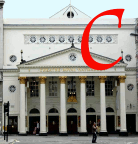
lassical architecture is a universal architecture of precision, planning, and control. Each element has its proper place and size, and each is subordinated to the greater plan. In antiquity, classicism was the architectural language of empire; in the nineteenth century is was the language of manifest destiny and of a Republic taming the wilderness; in the twentieth century, it became the language of fascism.
Ruskin expounded an (admittedly ahistorical) vision of the Gothic in opposition to the Classical, emphasizing savageness and changefulness as the touchstones of the Gothic. Changefulness refers to continuous change, as the vaulted rib has no single radius of curvature but changes continuously as it flies. Savageness refers to clean breaks, to asymmetry, to unique work expressed by different hands where structural constraints allow such variation. In classical architecture, each capital should be (or appear to be) identical; in gothic, the capitals must all be at the same height (lest the building collapse) but each may be carved in whatever way the workman can best carve them. In classical architecture, the architect controls every detail and sees that everything is done right. In gothic, the architect establishes the parameters and stands back while guilds and individual masons and chance all do their best. Because the Gothic idiom is changeful, the architect was free to say, “the East tower will be built here, and we will start at once; the West tower will be built there, but we may not be able to build it for twenty years, or seventy. It must lie where I put it and have the plan I specified, but when it is time to build the tower you may know better ways to build than I, and so the design allows for a great deal of variation in elevation and in decoration. [30-31]
Related material on this site
- Ruskin on the Gothic (from George P. Landow, Oxford University Press Past Masters Ruskin)
- Elizabeth K. Helsinger on Ruskin’s “The Nature of Gothic” (from The Art of the Beholder)
Related material outside this site
- Lars Spuybroek’s “Gothic Ontology and Sympathy.” Speculative Art Histories. 2013. Web. 14 November 2015. [cited in Bernstein below]
References
Bernstein, Mark. Getting Started with Hypertext Narrative. Watertown: Eastgate Systems, 2015.
Last modified 14 November 2015